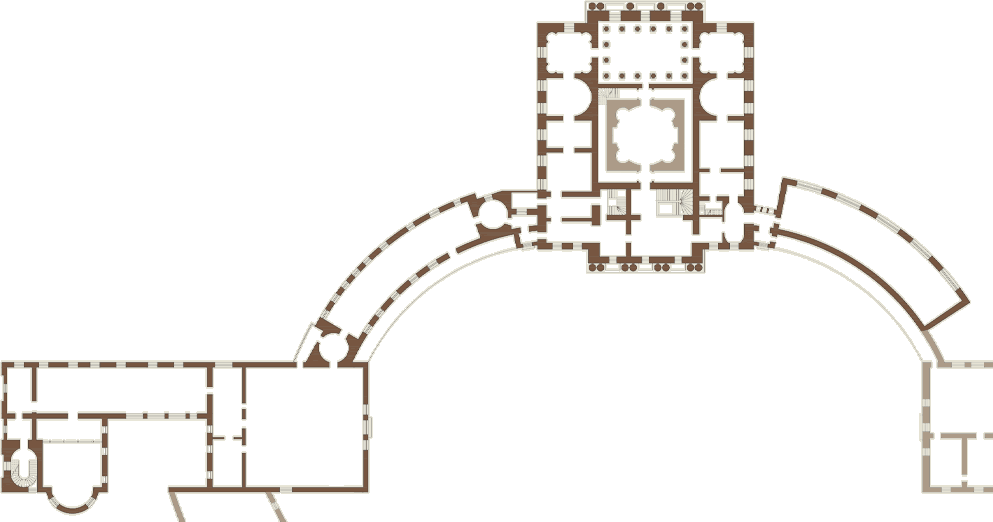The Library of Empress Maria Feodorovna
Загрузка панорамы...
The library begins the Southern State Suite of rooms. Its decoration was designed by Vincenzo Brenna ca. 1793. It is located symmetrically to the Carpet Study and has a layout identical to it. Just as the Carpet Study, Brenna decorated it with French tapestries presented by King Louis XVI. On the side walls, there are tapestries from the series Curtains of the Gods: Jupiter and Juno; they were made in the 1770s following the cartons of the decorator Claude Audran. They remain at their historical places. On the central wall, there was a tapestry from the series Love of the Gods based on the cartons of François Boucher. On a bright crimson background, two medallions depicted the scenes Jupiter Seducing Callisto and Vertumnus and Pomona. It was sold in 1932. After World War II, during the work on the revival of Pavlovsk, a French tapestry Don Quixote Talks with an Enchanted Head was placed here (Royal Tapestry Manufactory, master Pierre-François Cozette per the sketches by Charles Antoine Coypel, 1780), from the series Don Quixote, which also was presented to Pavel Petrovich by Louis XVI in 1782.
After the fire of 1803, Andrey Voronikhin, while preserving the Brenna's composition, made several changes. In particular, he introduced the grisaille painting of the frieze on ancient motifs. While this room is similar in its composition to the Carpet Study, this is a library first and foremost. Just as in the Library of Pavel Petrovich, there are low bookcases along the walls, holding books on history and ethnography, philosophy, medicine, botany, and travel. There are also encyclopedias, as well as works by French enlighteners: Diderot, Voltaire, and Rousseau, as well as Russian authors: Nikolay Karamzin and Vasily Zhukovsky. All this reflects the scope of interests of the enlightened hostess of Pavlovsk, who was an artist, a horticulturist, a botanist, and a bibliophile. Since the completion of the decoration, there is a collection of marble sculptures on the marble tops of the bookcases. This is a whole series of statues: Apollo Musagetes and the nine Muses, the reduced copies of ancient originals stored in the Vatican collection. They were made for Pavlovsk in the workshop of Carlo Albacini, a brilliant master of copying and restoring antique sculptures, commissioned by Grand Duke Pavel Petrovich, who was delighted with the antique collection after visiting the Vatican. There are also Italian marble busts and the sculpture Cleopatra (also known as Sleeping Ariadne). On the bookcases along the side walls, in the center, there were sculptures presented to the Count and Countess Du Nord by King Victor Amadeus III of Sardinia in 1782, during their stay in Turin. One of them, Pluto abducting Proserpine, remains in its place. On the base of the sculpture, is an inscription: “PAR LES FRERES COLLINI DE TURIN SCULPTEURS DU ROI DE SARDAIGNE FAITE A TURIN L'AN 1781 MARBRE DE CARRARA” (Made by the Collini brothers from Turin, sculptors of the King of Sardinia in Turin in the year 1781). The second sculpture, Vestal, by the same masters, disappeared during the war. After the war, an antique sculpture The Muse at the Rock was placed here, repeating the composition of the famous antique statue, usually considered to be the image of the muse of Polyhymnia.
A large desk (Germany, Roentgen, 1784) stands near the central rounded wall since the 1790s, and next to it, since 1805, there is an armchair with jardinieres for flowers installed in the back. Voronikhin designed this armchair specifically for Maria Feodorovna, a connoisseur and lover of flowers. The hall is illuminated by a chandelier in the form of a basket bound with a gilded bronze rim with elegant female heads. Two paired chandeliers of the Carpet Study and the Library of Maria Feodorovna were also done as per the Voronikhin's drawings.
Starting from this hall, all the rooms of the Southern Suite are decorated with mosaic parquet floors made of expensive multi-colored wood. Before the fire of 1803, mosaic parquet floors were installed in all the state rooms of the central building, but they were lost. No projects of drawings remained. During the restoration of the palace, Voronikhin replaced them everywhere with oak parquet block floors. During the post-war restoration, a parquet was laid in four halls of the state suite of Maria Feodorovna, made ca. 1780 per the project of architect Yury Felten for the Lansky house on Palace Square and subsequently moved to the favorite rooms of the Catherine Palace. The blocks with mosaic parquet floors from Lansky's chambers in Tsarskoye Selo that survived the fire were taken as a basis, restored, and supplemented by restorers. 12 valuable wood species are used in the parquet floors.
The Library of Empress Maria Feodorovna on the floor plane
- The Egyptian Vestibule
- The Carpet Study
- The Second Interconnecting Study
- The Main Staircase
- The Hall of War
- The Picture Gallery
- The Upper Vestibule
- The Greek Hall
- The Third Interconnecting Study
- The Italian Hall
- The Hall of Peace
- The Throne Room
- The Valet de Chambre Room of Paul I
- The Library of Empress Maria Feodorovna
- The Pantry
- The Dressing Room of Paul I
- The Boudoir
- The Orchestral Room
- The Rossi Study
- The State Bedroom
- The Knights Room
- The Rossi Library
- The Dressing Room of Maria Feodorovna
- The Chevalier Guard Room
- The Small Study of Emperor Paul I
- The Maid of Honour's Room
- The Anteroom (Turkish Room)
- The State Library of Paul I
- The First Interconnecting Study
- The Palace Church

Back
